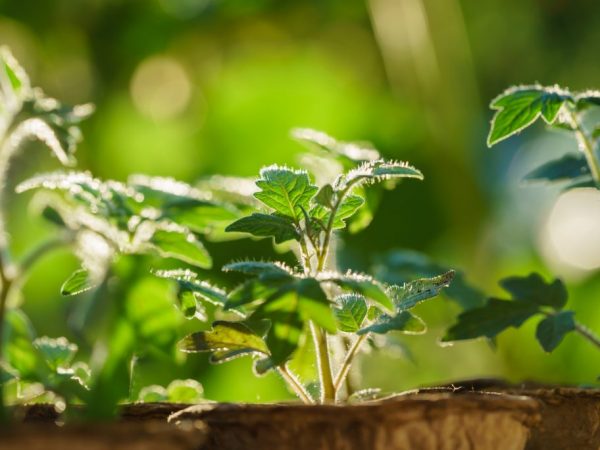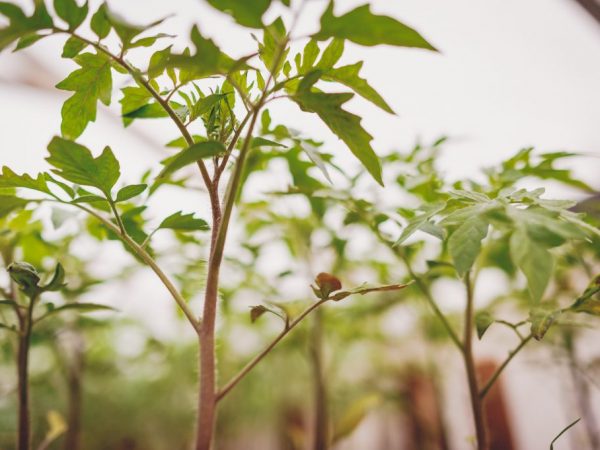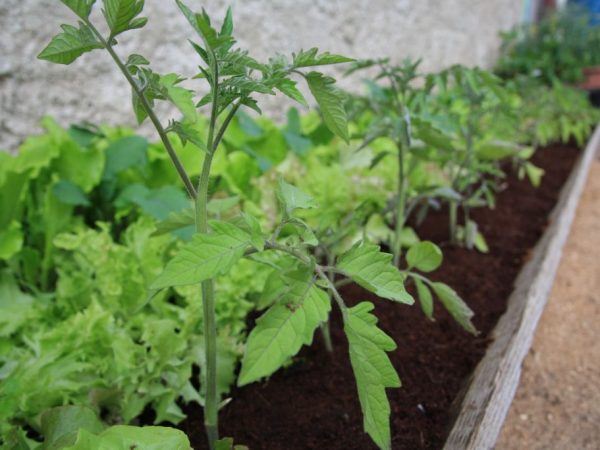The reason for poor growth of tomato seedlings
The future harvest depends on the quality of the seedlings, therefore, poor growth of seedlings and wilting of leaves is a serious problem that must be dealt with. There are many reasons for this phenomenon: the condition of the soil and even the care conditions created in the greenhouse. Seedlings of tomatoes grow poorly in confined conditions, in untreated soil and without fertilization. Having considered all the common reasons for the wilting of seedlings, the gardener will save the future harvest.

The reason for poor growth of tomato seedlings
Care features
Seedlings grow rapidly; it is found immediately after planting or after the formation of the main stem of the bush. Culture develops poorly if it lacks free space. Lack of moisture and nutrients affects the condition of the stems, leaves and fruits. Creating conditions for seedlings is the primary task of the gardener.
Why tomato seedlings do not grow or grow poorly:
- the temperature regime is not observed;
- insufficient nutrition;
- lack of nutrients and vitamins.
It is important that the right conditions are created in the greenhouse before planting tomatoes: first of all, before planting, the soil and all equipment are cleaned of harmful microorganisms.
Particular attention is paid to the temperature regime in the room, as soon as the first shoots appear, the boxes with the culture are removed to a cool place. During the day, the temperature should not drop to 10-14 ° C. The optimal temperature regime is 18 ° C during the day and 13 ° C at night, otherwise the seedlings will quickly dry out or begin to wither.
A bush develops well, which is sprayed with low-fat milk. This procedure will help to avoid fungal diseases in seedlings. A plant that is planted in uncleaned soil or in unfertilized soil (dry soil without minerals and vitamins) grows poorly. Whatever the reason for the poor growth of seedlings, it must be eliminated, otherwise it will not be possible to get a good harvest.
What does growth depend on?
Only 3 factors affect the growth of seedlings: the conditions created in the greenhouse or in an open area, the care and treatment of the bushes. The problem at every stage of seedling growth points to the reason the plant withers quickly.
Tomato seedlings do not grow in depleted soil if the soil has been used for planting other crops, especially root crops, for several years in a row. The nutrition of the stem and the development of lashes depend on watering, and in the future - the appearance of the first inflorescences and greens. A picking is very important, which is carried out until the main bush is formed. Tomato pests and diseases can affect the growth and formation of the first crop ovaries.
Soil quality
If the seedlings do not grow well, the first step is to check the condition of the soil.
The soil determines the growth of the root system and the main stem of tomatoes. If the quality characteristics of the soil are not suitable for the growth of seedlings, the leaves begin to wither, and root rot appears. Another sign of poor soil is the bluish tint of the seedlings.The leaves turn blue if there is not enough magnesium in the soil.

Lack of nitrogen can provoke stunted growth
Seedlings grow poorly due to lack of nitrogen.
The trace element is especially important for strengthening the plant, for the growth of seedlings into a full-fledged bush. Nitrogen enriches the soil with oxygen and saturates the root system with it. Without nitrogen, a weak, deformed bush and small fruits are formed - it is impossible to harvest a good harvest in such conditions. The main symptom of a nitrogen deficiency is the depletion of leaves and stems.
Solution to the problem
Magnesium helps to develop the root system of tomatoes, if there is a lack of such an important element in the soil, the plant quickly weakens.
Getting magnesium from natural products at home is very difficult. It is easier to buy magnesium-containing fertilizers that are suitable for feeding the soil for tomatoes. Magnesium is sold in powder or granules. They are diluted with water: with the resulting mixture, the soil around the bush and neighboring crops is irrigated. To dilute the mixture to the desired concentration, use the instructions (you must adhere to the exact proportions).
What to do if there is not enough nitrogen in the soil:
- fertilize with urea;
- fertilize with wood ash;
- fertilize with purchased nitrogen-containing powders.
Nitrogen is sold as a powder that is soluble in water. To dilute the fertilizer, use warm purified water (1 tablespoon fertilizer per 10 liters of water).
If the seedlings do not grow due to a lack of nitrogen, fertilizer is applied 2 times a week for a month.
It is necessary to use a nitrogen-containing additive for tomatoes carefully: excess nitrogen in the soil will harm the fruit. It is important to follow the instructions for the purchased fertilizer. If the top layers of the soil are sprinkled with wood ash, the growth of the seedlings is gradually restored.
Improper watering
If there are no problems with the soil, but the seedlings of the planted tomatoes still grow poorly, it is necessary to reconsider the care. If the leaves of the plant begin to turn yellow, the tomato lacks moisture or too much moisture. This leads to rotting of the root system of the future tomato bush.
Watering the seedlings is scheduled according to the schedule: no more than 2 times a week during the period of active growth of tomatoes. Before planting seedlings, the soil is abundantly watered and fertilized, the next watering occurs no earlier than a week later. A crop will not grow if excess moisture causes the roots to rot.
Solution to the problem
If it is not possible to determine the right amount of moisture for tomatoes, it is necessary to check the quality of the soil. If the earth is dry, water is added, if moisture is not absorbed, watering is stopped for a while.
Installing an irrigation system will help solve the problem. Drip or autonomous irrigation will save seedlings from excess or lack of moisture.
The moisture level varies depending on the place of planting: on the south side, moisture evaporates faster, and in the shade, irrigation water can stagnate at the root system. It is necessary to take into account the temperature regime of the environment and the level of moisture in the region where the culture is planted.
Wrong pick

The quality of the pick affects the growth of plants.
Picking is the removal of the end part of the taproot. This procedure stimulates the branching of the root system and accelerates the growth of tomato bushes. If the pick was carried out incorrectly or the plant did not receive proper care after the procedure, the seedlings either do not grow at all, or they do it very slowly.
The reasons for the insufficient growth of seedlings:
- the root system is bent incorrectly;
- during the procedure, the roots were torn off too much;
- damage to the roots during planting in the ground;
- the roots were poorly squeezed out, as a result of which an air gap formed in the soil.
It is important to dive according to all the rules: any damage to the root system of tomatoes can lead to the death of the crop. After the pick, the plant does not grow well, then it is necessary to check the condition of the root system and improve its nutrition.
The entire subsequent period after the procedure, the soil is abundantly watered and fertilized. For replenishment, natural fertilizers or mineral complexes are used, which accelerate the development of the main stem.
Diseases of tomatoes
Diseases of the stem and root of tomatoes are the main problem of gardeners. Fungal diseases and infections affect cultures at any stage of development. Diseases are the main factor why seedlings do not grow or quickly lose juices. Common problems:
- root rot;
- blackleg;
- late blight.
Excessive watering of the crop or low ambient temperatures leads to the appearance of root and root rot. With such a disease, the seedling does not grow for a long time and gradually decays.
An infectious disease (black leg) develops rapidly and spreads to neighboring cultures. It is dangerous for the entire garden, therefore it is difficult to treat.
Solution to the problem
What if the seedlings are infected? If the seedlings have suffered from root and root rot, they should be urgently transplanted into a new cleaned and disinfected soil. Plants heavily affected by rot are thrown away. The soil after the diseased culture is replaced with soil, washed with a solution of potassium permanganate.
To clean the stems, use "Fitosporin" - an effective and safe commercial preparation. The whole culture is treated with it. From the black leg, the plant is treated with a solution of potassium manganese. Seedlings planted close to each other are seated.
The room where the plants grow is well ventilated.
It is possible to save a softened stem with a dark stem only at the initial stage of the disease.
Pests and insects
Tomato seedlings do not grow due to pests. Among them, the most dangerous are spider mites, wood lice or earwigs. The leaves of a seedling attacked by pests turn yellow, their edges are deformed: holes or dark spots appear.
Fitoverm or Aktellik are capable of helping the culture. The funds are used strictly according to the instructions.
The land is cultivated on a large scale: diseased crops and neighboring plants are sprayed. An integrated approach will get rid of pests and protect future crops.
Insecticides are used with caution, especially during the period of active growth of seedlings. Processing should only be carried out by a professional.


